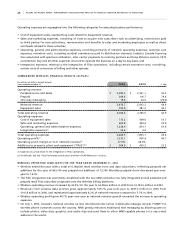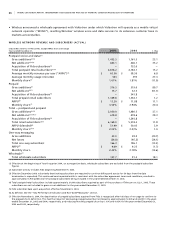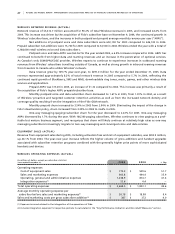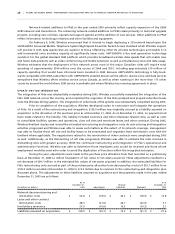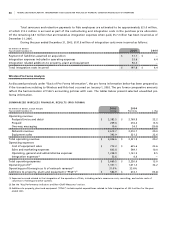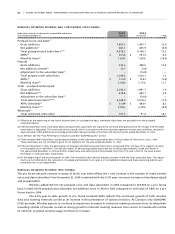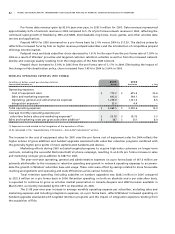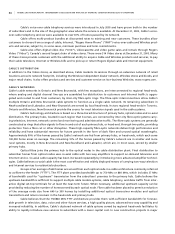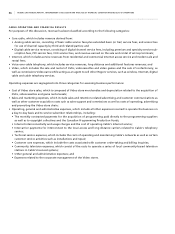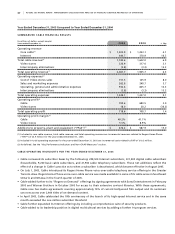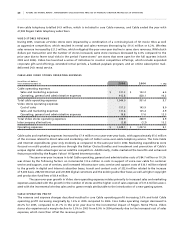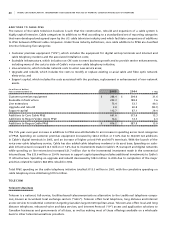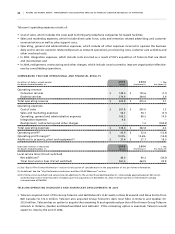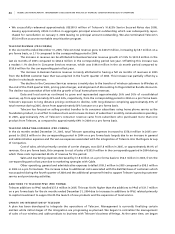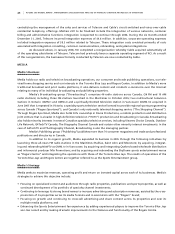Rogers 2005 Annual Report Download - page 39
Download and view the complete annual report
Please find page 39 of the 2005 Rogers annual report below. You can navigate through the pages in the report by either clicking on the pages listed below, or by using the keyword search tool below to find specific information within the annual report.
35 ROGERS 2005 ANNUAL REPORT . MANAGEMENT’S DISCUSSION AND ANALYSIS OF FINANCIAL CONDITION AND RESULTS OF OPERATIONS
urban areas, Cable is now deploying a cable network architecture commonly referred to as fibre-to-the-curb (“FTTC”).
This architecture provides improved reliability due to fewer active network devices being deployed. FTTC also provides
greater capacity for future narrowcast services.
Cable’s voice-over-cable telephony services are offered over an advanced broadband Internet Protocol (“IP”)
multimedia network layer deployed during 2004 and 2005 across Cable’s service areas. This network platform provides
for a scalable primary line quality digital voice-over-cable telephony service utilizing Packet Cable and Data Over Cable
Service Interface Specification (“DOCSIS”) standards, including network redundancy as well as multi-hour network and
customer premises powering.
Cable’s Strategy
Cable seeks to maximize revenue, operating income, and return on invested capital by leveraging its technologically
advanced cable network to meet the information, entertainment and communications needs of its subscribers, from
basic cable television to advanced two-way cable services, including digital cable, Internet access, voice-over-cable tele-
phony service, PPV, VOD, SVOD, PVR and HDTV. The key elements of the strategy are as follows:
• Clustering of cable systems in and around metropolitan areas;
• Offering a wide selection of products and services;
• Maintaining technologically advanced cable networks;
• Continuing to focus on increased quality and reliability of service;
• Leveraging its relationships within the Rogers Group of Companies to provide bundled product and service offerings
at attractive prices, in addition to implementing cross-selling and joint sales distribution initiatives as well as cost-
reduction initiatives through infrastructure sharing;
• Continuing to develop brand awareness and to promote the “Rogers” brand as a symbol of quality, innovation and
value and of a diversified Canadian media and communications company; and
• Expanding the availability of its high-quality digital primary line voice-over-cable telephony service into most of the
markets in its cable service areas.
Recent Cable Developments
In January 2006, RCI completed a reorganization whereby Cable acquired substantially all of the operating subsidiaries
of Telecom. Telecom had previously been a separate operating segment of RCI. As a result of this reorganization, the
businesses formerly conducted by Telecom are now conducted by Cable. As a result of the changes to management’s
reporting, beginning in 2006, our reporting segments will change.
Recent Cable Industry Trends
IN V E ST M EN T I N IM P RO V ED C AB L E T EL E V IS I ON NET W OR K S A ND E XP A ND E D S E RV I CE OFF E RI N GS
In recent years, North American cable television companies have made substantial investments in the installation of
fibre-optic cable and electronics in their respective networks and in the development of Internet, digital cable and
voice-over-cable telephony services. These investments have enabled cable television companies to offer expanded pack-
ages of analog and digital cable television services, including VOD, SVOD, and PPV services; expanded analog and digital
services, pay television packages, PVR, HDTV programming, multiple tiers of Internet services and telephony services.
IN C R EA S ED C O M PE T IT I ON FR O M A LT E RN A TI V E B RO A DC A S TI N G DI S T RI B UT I ON UN D ER T AKI N GS
Canadian cable television systems generally face legal and illegal competition from several alternative multi-channel
broadcasting distribution systems.


